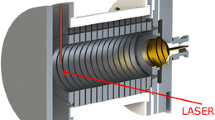Abstract
A laser-based ionization source for the direct analysis of liquid samples in ion mobility (IM) spectrometry is presented and characterized. Ionization of aromatic substances in liquids is achieved, analogous to atmospheric pressure laser ionization (APLI) in mass spectrometry, by vaporizing the liquid and subsequently ionizing the aromatic substances by resonance-enhanced multiphoton ionization (REMPI). The effects of parameters, such as composition and flow rate of the solvent as well as laser wavelength and pulse energy, are systematically investigated. The characterization of the IM spectrometer is carried out by means of selected substances from diverse fields of applications, e.g., polycyclic aromatic hydrocarbons (PAH), pesticides, wood preservatives and drug compounds. Limits of detection (LOD) down to 10 fmol and linear ranges up to three orders of magnitude are established. In addition to direct laser ionization, indirect laser ionization via dopants (toluene) for substances with low ionization efficiencies is investigated. Ionization occurs as a result of proton transfer from toluene radical cations to substances of sufficiently high proton affinities. As a result of indirect laser ionization, LOD could be decreased by up to two orders of magnitude. Ionization products are investigated by means of a combination of IM and mass spectrometer. Depending on the substance investigated primary ions (radical cations) and secondary ions (protonated molecules) resulting from ion molecule reactions are formed.

















Similar content being viewed by others
References
Eiceman GA, Karpas Z (2005) Ion mobility spectrometry. CRC Press, Boca Raton
Borsdorf H, Mayer T, Zarejousheghani M, Eiceman GA (2011) Recent developments in ion mobility spectrometry. Appl Spectrosc Rev 46:472–521
Baumbach JI (2006) Process analysis using ion mobility spectrometry. Anal Bioanal Chem 384:1059–1070
Tabrizchi M, Ilbeigi V (2010) Detection of explosives by positive corona discharge ion mobility spectrometry. J Hazard Mater 176:692–696
Ewing RG, Atkinson DA, Eiceman GA, Ewing GJ (2001) A critical review of ion mobility spectro-metry for the detection of explosives and explosive related compounds. Talanta 54:515–529
Hill HH, St Louis RH, Morrissey MA, Shumate CB, Siems WF, McMinn DG (1992) A detection method for unified chromatography. J High Resolut Chromatogr 15:417–422
Boesl U (1991) Multiphoton excitation and mass‐selective ion detection for neutral and ion spectroscopy. J Phys Chem 95:2949–2962
Boesl U (2000) Laser mass spectrometry for environmental and industrial chemical trace analysis. J Mass Spectrom 35:289–304
Lubman DM, Kronick MN (1983) Multiwavelength-selective ionization of organic compounds in an ion mobility spectrometer. Anal Chem 55:867–873
Gormally J, Phillips J (1991) The performance of an ion mobility spectrometer for use with laser ionization. Int J Mass Spectrom Ion Process 107:441–451
Löhmannsröben H-G, Beitz T, Laudien R, Schultze R (2004) Laser-based ion mobility spectro-metry for sensing of aromatic compounds. Proc SPIE 5547:16–24
Robb DB, Covey TR, Bruins AP (2000) Atmospheric pressure photoionization: an ionization method for liquid chromatography-mass spectrometry. Anal Chem 72:3653–3659
Hanold KA, Fischer SM, Cormia PH, Miller CE, Syage JA (2004) Atmospheric pressure photoioni-zation. 1. General properties for LC/MS. Anal Chem 76:2842–2851
Schiewek R, Lorenz M, Giese R, Brockmann K, Benter T, Gäb S, Schmitz OJ (2008) Development of a multipurpose ion source for LC-MS and GC-API MS. Anal Bioanal Chem 392:87–96
Schrader W, Panda SK, Brockmann KJ, Benter T (2008) Characterization of non-polar aromatic hydrocarbons in crude oil using atmospheric pressure laser ionization and Fourier transform ion cyclotron resonance mass spectrometry (APLI FT-ICR MS). Analyst 133:867–869
Brendler C, Riebe D, Ritschel T, Beitz T, Löhmannsröben H-G (2013) Investigation of neuroleptics and other aromatic compounds by laser-based ion mobility mass spectrometry. Anal Bioanal Chem 405:7019–7029
P.J. Linstrom and W.G. Mallard, Eds., NIST Chemistry WebBook, NIST Standard Reference Database Number 69, National Institute of Standards and Technology, Gaithersburg MD, 20899, http://webbook.nist.gov, (retrieved April 4, 2014)
Acknowledgments
The authors would like to thank the German Federal Ministry of Education and Research (BMBF) for financial support and the PT Jülich for organizational support within the ForMaT project (FKZ: 03FO1042).
Author information
Authors and Affiliations
Corresponding author
Rights and permissions
About this article
Cite this article
Brendler, C., Riebe, D., Zenichowski, K. et al. Laser-based ion mobility spectrometer for the direct analysis of aromatic compounds in liquids. Int. J. Ion Mobil. Spec. 17, 105–115 (2014). https://doi.org/10.1007/s12127-014-0158-4
Received:
Revised:
Accepted:
Published:
Issue Date:
DOI: https://doi.org/10.1007/s12127-014-0158-4




